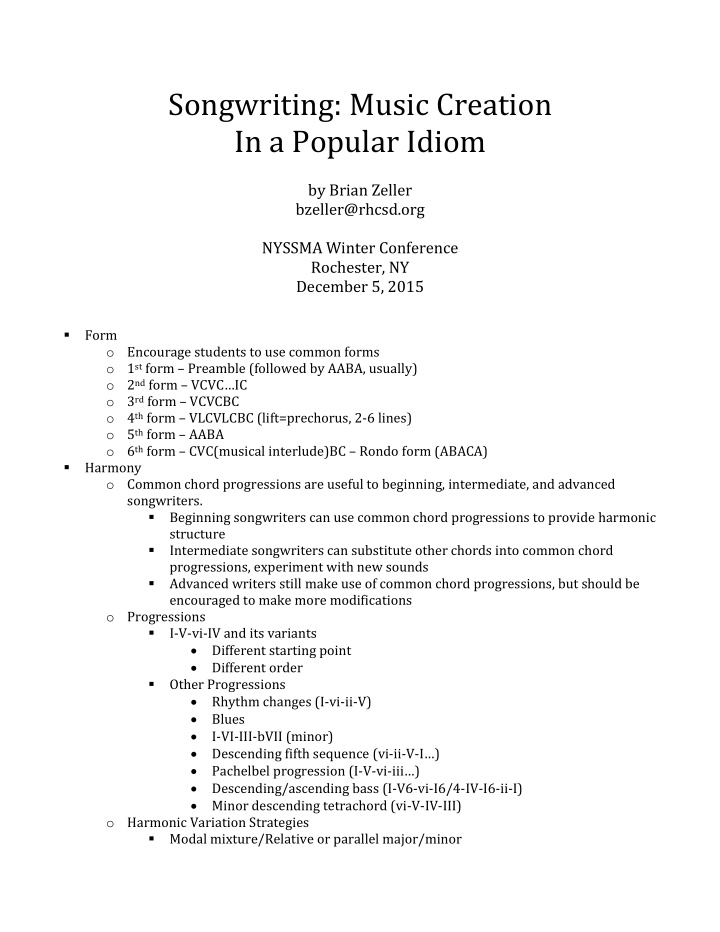



Songwriting: Music Creation In a Popular Idiom by Brian Zeller bzeller@rhcsd.org NYSSMA Winter Conference Rochester, NY December 5, 2015 Form o Encourage students to use common forms o 1 st form – Preamble (followed by AABA, usually) o 2 nd form – VCVC…IC o 3 rd form – VCVCBC o 4 th form – VLCVLCBC (lift=prechorus, 2-6 lines) o 5 th form – AABA o 6 th form – CVC(musical interlude)BC – Rondo form (ABACA) Harmony o Common chord progressions are useful to beginning, intermediate, and advanced songwriters. Beginning songwriters can use common chord progressions to provide harmonic structure Intermediate songwriters can substitute other chords into common chord progressions, experiment with new sounds Advanced writers still make use of common chord progressions, but should be encouraged to make more modifications o Progressions I-V-vi-IV and its variants Different starting point Different order Other Progressions Rhythm changes (I-vi-ii-V) Blues I-VI-III-bVII (minor) Descending fifth sequence (vi-ii-V- I…) Pachelbel progression (I-V-vi- iii…) Descending/ascending bass (I-V6-vi-I6/4-IV-I6-ii-I) Minor descending tetrachord (vi-V-IV-III) o Harmonic Variation Strategies Modal mixture/Relative or parallel major/minor
Alternate bass notes Passing chords – diatonic planing, diminished chords, etc. Hybrid progressions Modulation Melody o Melodic and instrumental hooks are essential to a song o Crafting a Strong Melody Repetition, repetition, repetition Should be singable Emphasize steps or small skips over leaps Keep within reasonable vocal range Notes in melody should compliment harmonic choices Interaction of melody of lyrics The melody and lyrics need to work together As lyrics get busier, melody gets simpler Melody should reinforce strong and weak syllables of lyric Be aware of rhythmic and melodic accents Working with student songwriters o Creative Process Varies from writer to writer. Encourage students to experiment to find their method. Melody/lyrics: which comes first? Save every idea – don’t trust memory o Great songwriters are great editors o Social Concerns Reluctance to share - Creating and sharing anything can make a student feel vulnerable. Share with teacher individually or in small groups – minimizes social risks for students Ask students to provide positive feedback about each others’ p ieces Over time, work to create an environment of trust and openness in songwriting groups. Personal topics - Some students find songwriting to be an outlet for expressing feelings and emotions difficult to express any other way. These autobiographical songs can be especially difficult to share with others. o Encourage students to create a character and write from the voice of that character. o Song can draw on personal experiences and emotions but with detachment, and thus protection o I also try to exercise restraint in asking students where they got the idea for a song. o Musical Concerns Rhyme scheme Student presents song with incoherent rhyme scheme
o Ask students to analyze lyrics of 3-5 of their favorite songs, circling and linking rhyming words, then specify rhyme scheme (e.g. ABAB) o Strongly encourage students to maintain rhyme scheme for all similar sections in song (i.e. all verses) o Encourage use of rhyming dictionary and thesaurus (many are free, available online) Melody Student presents song with rambling, run-on, or otherwise or unmemorable melody Lack of repetition o What is student’s favorite part of melody? o Can this become the basis of a new, more unified melodic idea? No Hook o Prioritize writing a memorable hook. o Identify most memorable part of melody in several favorite songs. What makes it memorable? o Have students write hooks and sing them for each other. Can they remember each others’ hooks after a few minutes? Harmony Student presents a song with harmonic issues o Melody does not match chords Point out problem areas, propose specific solutions with less experienced writers o Chord progression eccentricities Unusual chord progressions, if they work , are okay Such progressions make writing more difficult Encourage less-experienced writers to use standard chord progressions, perhaps with simple modifications Building on songwriting o All musical building blocks of songwriting – form, harmony, melody, et al. o Arranging o Recording and production o Notation o Composition o Suggested resources Murphy, Ralph J. Murphy’s Laws of Songwriting . Nashville: Murphy Music Consulting, 2011. Jordan, Barbara L. Songwriters Playground: Innovative Exercises in Creative Songwriting. Booksurge Publishing, 2008. Pattison, Pat. Writing Better Lyrics: The Essential Guide to Powerful Songwriting. Cincinatti: Writers Digest Books, 2009. Pattison, Pat. Songwriting Without Boundaries: Lyric Writing Exercises for Finding Your Voice. Cincinatti: Writers Digest Books, 2011.
Recommend
More recommend